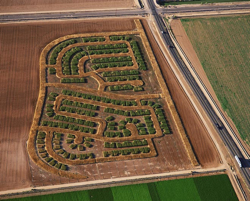 It’s a good weekend for unconsidered and diverse ramblings. Take the latest news to arrive on sorghum: an artist called Matthew Moore used sorghum and black-bearded wheat to create a scale-replica of a housing estate being built on land sold by his family. The houses are sorghum, the roads wheat. And the wheat wasn’t wasted. A local farmer so liked the piece that he harvested it for free. Details of the project, and Moore’s other work, here.
It’s a good weekend for unconsidered and diverse ramblings. Take the latest news to arrive on sorghum: an artist called Matthew Moore used sorghum and black-bearded wheat to create a scale-replica of a housing estate being built on land sold by his family. The houses are sorghum, the roads wheat. And the wheat wasn’t wasted. A local farmer so liked the piece that he harvested it for free. Details of the project, and Moore’s other work, here.
Photo by Matthew Moore, from WFMU.